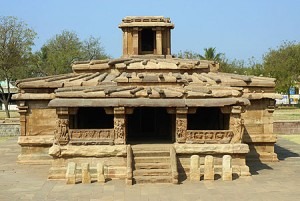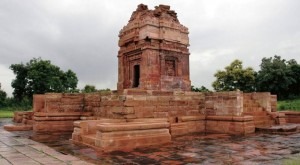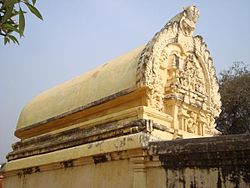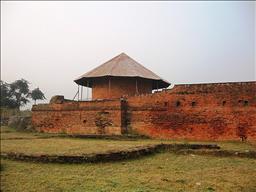How a Gupta era temple in Etah has put focus back on shankhalipi script?.
 The discovery of Gupta era temple in Etah district of Uttar Pradesh by Archaeological Survey of India (ASI) has put back the focus on the shankhalipi script.
The discovery of Gupta era temple in Etah district of Uttar Pradesh by Archaeological Survey of India (ASI) has put back the focus on the shankhalipi script.
- The script in the temple was deciphered as saying, ‘Sri Mahendraditya’, the title of Kumaragupta I of the Gupta dynasty.
- Shankhalipi or shell-script is a term used to describe ornate spiral characters assumed to be Brahmi derivatives that look like conch shells or shankhas.
- They are found in inscriptions across north-central India and date to between the 4th and 8th centuries.
- Shankhalipi is found to be engraved on temple pillars, columns and rock surfaces.
- Both Shankhalipi and Brahmi are stylised scripts used primarily for names and signatures.
- The inscriptions consist of a small number of characters, suggesting that the shell inscriptions are names or auspicious symbols or a combination of the two.
Chronology
- The script was discovered in 1836 on a brass trident in Uttarakhand’s Barahat by English scholar James Prinsep.
- He was the founding editor of the Journal of the Asiatic Society of Bengal.
- Later, two more similar scripts were found at Nagarjuna group of caves in the Barabar Hills near Gaya, Bihar.
- Prominent sites with shell inscriptions include:
- Mundeshwari Temple in Bihar
- Udayagiri Caves in Madhya Pradesh
- Mansar in Maharashtra
- Some cave sites of Gujarat and Maharashtra
- Also reported in Indonesia’s Java and Borneo.
- The attempts to decipher shell script have not been successful.
- No such inscriptions with dates or numbers have been reported so far even as their chronology can be determined by the objects on which they are written.
Related News item
1500-year-old temple remains found in Uttar Pradesh
The Archaeological Survey of India (ASI) discovered the remnants of an ancient temple dating back to the 5th century CE, the Gupta period, in Etah, Uttar Pradesh.
- The stairway includes Shankhalipi inscriptions which state ‘Sri Mahendraditya,' the title of the Gupta emperor Kumaragupta I.
- Shankhalipi is an elaborate, stylized ancient script that was employed for names and signatures between 4th and 8th century CE.
- There were two ornamental pillars that were near to one other and had human sculptures on them.
Etah Ruins:
- The writing discovered on the Etah skeletons has previously been discovered on a horse statue in Lakhimpur Kheri.
- The bones were dated to Kumaragupta 1's reign.
- The Etah ruins are the third Gupta era structure temple discovered so far.
- Earlier, only two structural temples were found — Dashavatara Temple in Deogarh and Bhitargaon Temple in Kanpur Dehat.
Kumaragupta-1:
- Kumaragupta 1 was the son and successor of Chandragupta II.
- Reign: 414 - 455 AD
- Adopted the titles of ‘Shakraditya’ and ‘Mahendraditya’.
- Performed ‘Ashvamedha’ sacrifices.
- He laid the foundation of Nalanda University which emerged as an institution of international reputation.
Famous Inscriptions of Kumaragupta's reign:
- These are – Karandanda, Mandsor, Bilsad inscription (oldest record of his reign) and Damodar Copper Plate inscription.
Temple architecture during Gupta period:
- Gupta period marks the beginning of Indian temple architecture.
- Manuals were written regarding how to form temples.
The Gupta temples were of five main types:
Type 1:

- Square building with flat roof
- Shallow pillared porch
- Sanctum (garbhagriha) at the center of the temple
- A single entrance & porch (Mandapa)
- Mandapa appears to originate 1st from here
- Example- Vishnu Varaha temples in (MP)
Type 2

- Square temple with a squat tower (shikhara) above
- Pillared approach, a high platform at the base
- Examole- Ladkhan Temple at Aihole (Karnataka)
Type 3

- An elaboration of the first type
- Addition of an ambulatory (paradakshina) around the sanctum
- Most unique achievement of this stage was “Curvilinear tower” i.e., “Shikhara”.
- “Nagara Style” of temple making.
- Example- Dasavatara temple (Deogarh, Jhansi)
Type 4

- Rectangular temple with an apsidal back
- Barrel-vaulted roof above
- Example- Kapoteswara temple at Cezarla (Andhra Pradesh)
Type 5

- Circular temples with shallow rectangular projection
- Example- Maniyar Math shrine at Rajgir, Bihar
Next
previous
 The discovery of Gupta era temple in Etah district of Uttar Pradesh by Archaeological Survey of India (ASI) has put back the focus on the shankhalipi script.
The discovery of Gupta era temple in Etah district of Uttar Pradesh by Archaeological Survey of India (ASI) has put back the focus on the shankhalipi script.














 Latest News
Latest News
 General Studies
General Studies